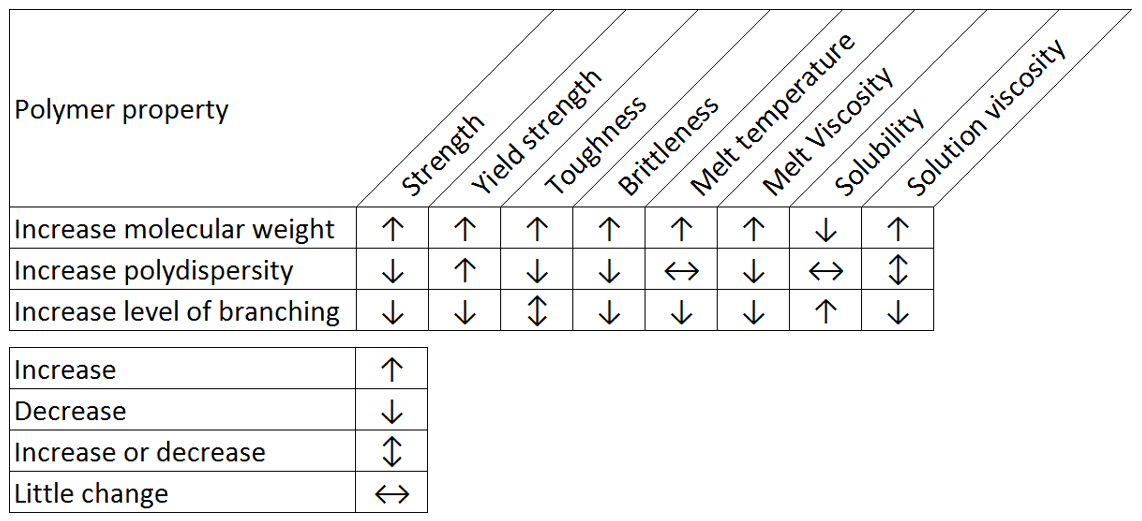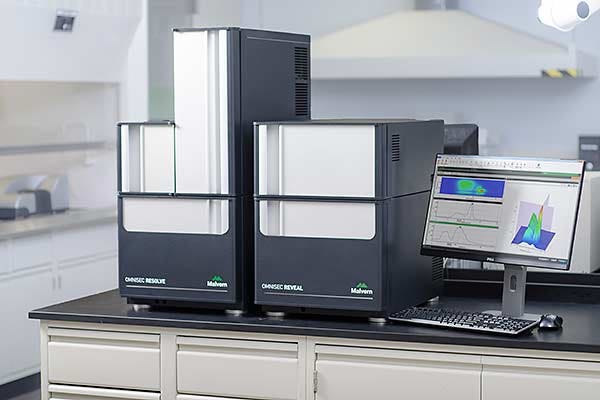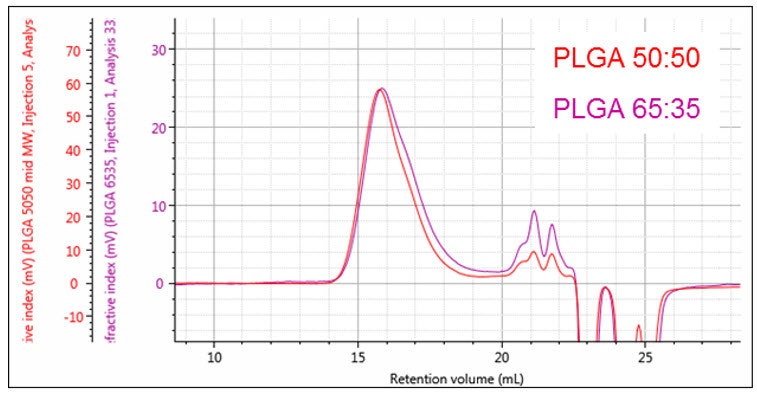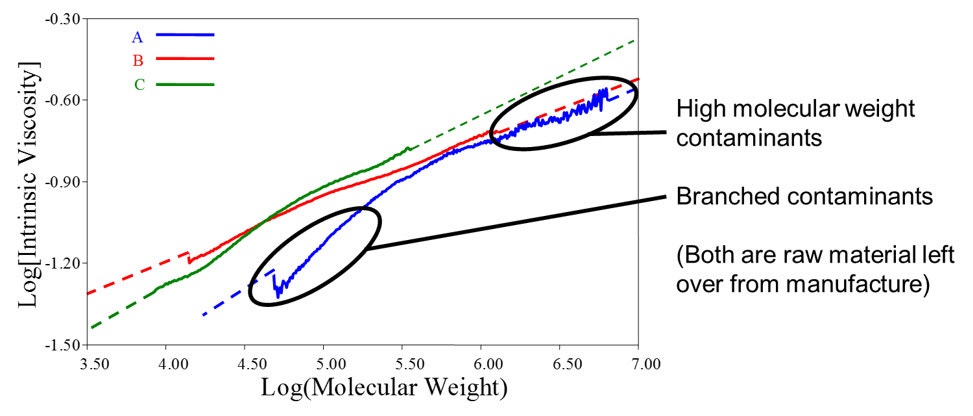The top ten reasons to consider an advanced multi-detector GPC system, which incorporates light scattering detectors for the measurement of absolute molecular weight and molecular weight distribution with excellent accuracy.
Gel-permeation chromatography (GPC) is an essential tool for the characterization of polymers. It allows polymer scientists to tailor a polymer’s properties to its end use requirements by controlling its molecular properties, since the two are inextricably linked. For example, increasing a polymer’s molecular weight can increase its strength but there are many other effects that the molecular properties can have on the bulk ones. Table 1 gives an example of the connections although the real links will be specific to each polymer under study.

Table 1: Effect of molecular weight, polydispersity and structure on the bulk properties of a polymer
Multi-detector GPC is a development over and above single detector systems, which are often called “conventional GPC”. A single-detector system typically includes a refractive index (RI) detector and is used to make measurements of molecular weight by comparing a sample’s elution time against that of standards with known molecular weight.
Single-detector conventional systems have been available since the development of this separation technique and are used throughout industry and academia. They are used for a wide range of applications, such as synthetic polymer development, manufacture and QC, polysaccharide preparation, grading, and blending. There are a number of reasons why they are so popular including, most importantly, their repeatability and reproducibility, their robustness, and their simplicity and accessibility. However, if the standards and samples are different molecules, the results can only ever be comparative.
The technology has advanced, however, and with additional detectors comes a wealth of information. Light scattering detectors, whether SEC-MALS, RALS, or LALS (multi-angle, right-angle or low-angle light scattering), measure absolute molecular weight and molecular weight distribution with excellent accuracy. A viscometer allows measurement of molecular structure and branching, and multiple concentration detectors allow compositional analysis of copolymers. The combination of these detectors allows for complete characterization of polymers without the compromises of relative measurements or chromatography setup dependencies.
Developing novel polymers and achieving their maximum potential can only be achieved when the polymer is fully characterized. With these benefits in mind, this white paper lists the top ten reasons you need an advanced multi-detector GPC system.

|
The greatest limitation of conventional GPC/SEC is the way molecular weight is calculated. Since molecular weight comes from retention volume (which is directly related to the sample’s hydrodynamic volume) and a comparison with molecular weight standards, the calculated results are only accurate if the standards are the same material as the sample. Conventional calibration is blind to changes in sample type, structure, chemistry/composition and branching.
As more and more modern polymers enter the market, fewer and fewer of them have standards that can be used. Measuring a relative molecular weight may be sufficient if the only thing that matters is that two production batches are the same, but modern applications require greater accuracy, particularly in the research and development stages where real control of a polymer’s properties come from accurate knowledge of its molecular weight. The addition of a light scattering detector means that from now on, all of your molecular weight measurements will be accurate, irrespective of the polymer being measured. Absolute molecular weight means a better understanding of your sample, better control over its properties and a better quality product. In research, absolute molecular weight means a better understanding and control of your novel polymer development or synthesis.
For example, PLGA is a drug delivery molecule that can have a range of molecular weights and also a range of compositions as it is a copolymer of poly-lactic acid and poly-glycolic acid. It has no molecular weight standards so cannot be accurately measure using single-detector techniques. Moreover, its variable composition means that, measured molecular weights from single-detector measurements cannot even be reliably comparative. In the example in Figure 2, two RI chromatograms for two PLGA samples of different molecular weight and different composition are overlaid. Apart from slightly different concentrations, which have been normalized using the y-axis scales, the two samples look very similar. In reality though they have different composition, structure and molecular weight. Multi-detector measurements are not affected by the structural and compositional differences and so can measure the correct molecular weight as shown in the Table 2. They can also measure those structural differences. These measurements ensure accurate results and a thorough understanding of the sample under study.

Figure 2: Overlaid RI chromatograms for PLGA 50:50 and PLGA 65:35 (left).
| Sample ID | PLGA 50:50 | PLGA 65:35 |
|---|---|---|
| RV (mL) | 15.75 | 15.84 |
| Mn (g/mol) | 33,710 | 30,390 |
| Mw (g/mol) | 52,360 | 46,100 |
| Mz (g/mol) | 74,810 | 65,020 |
| Mw/Mn | 1.561 | 1.517 |
| IVw (dL/g) | 0.3378 | 0.3407 |
| Rh(n)w (nm) | 6.339 | 6.088 |
| M-H a | 0.5636 | 0.5703 |
| M-H log K (dL/g) | -3.111 | -3.109 |
One key advantage of a conventional calibration, single-detector system is its repeatability. However, that repeatability comes from the fact that it only provides limited information. It could well be that there are underlying differences which are not visible. For instance, conventional calibration could not distinguish between a linear sample and a branched sample of slightly higher molecular weight.
If, in research, you have ever had similar polymers from similar syntheses, yet they display distinct properties, or in industry, if you’ve ever had two production batches pass QC only for one to be returned from an unhappy customer complaining of poor performance then you are suffering from your conventional system’s inability to distinguish the underlying differences that are controlling your product’s quality. These undiagnosed bad batches mean more quality issues, higher costs, unhappy customers, damage to your profitability and to your brand.
A multi-detector system sees through these problems to help you manufacture quality product every time. This means a higher quality and a higher value product that your customers will appreciate all the more.
For example, a maltodextrin manufacturer we know was struggling with a bad batch of product, which looked the same to their own QC measurements. As can be seen in the Mark-Houwink plot in Figure 3 though, multi-detector GPC can rapidly identify the differences. Sample A, the bad batch contains more high molecular weight material and branched material. These are both left over from the raw material in the production process, starch, and clearly identify the source of the failure.
With this information, quality issues can be identified sooner, quality can be controlled to a higher standard, the number of customer complaints can be reduced and the value of your product significantly increased.

Figure 3: Overlaid RI chromatograms for linear (red) and branched (purple) polystyrenes. Conventional measurements are unable to see the significant differences in molecular weight and structure.
If you are interested in polymer structure, there are no better tools for investigating this than the Mark-Houwink (intrinsic viscosity vs molecular weight) or Conformation Plots (Rg vs molecular weight). These allow you to visually compare and contrast molecular density or size as a function of molecular weight, both of which are directly related to structural changes within a sample.
If you are manufacturing a branched polymer, then these plots allow you to visualize and to quantify the level of branching in a given sample. For example, figure 4 shows the difference between a linear and branched sample of polystyrene. The differences are easily measured and visualized using multi-detector GPC and a Mark-Houwink plot. These samples will have different bulk properties based on these structural differences and they can be inferred based on the relationships described in Table 1.
If you are using a natural polymer or polysaccharide derivative for use as a viscosity modifier (e.g. hydroxyethyl cellulose) in foods or creams, the level of substitution will strongly affect the product’s performance and cannot be characterized with conventional methods or bulk measurements of viscosity. This can also be easily observed with a Mark-Houwink or Conformation Plot. Once target Mark-Houwink values have been identified, production of the polysaccharide product can again be more tightly controlled, increasing a product’s quality and value.
For example, Figure 4 shows the difference between a linear and branched sample of polystyrene. The differences are easily measured and visualized using multi-detector GPC and a Mark-Houwink plot. These samples will have different bulk properties based on these structural differences and they can be inferred based on the relationships described in Table 1.
In research, measuring structure and conformation of a novel polymer are vitally important parts of its characterization. A better understanding of the results of a new synthesis means faster development and more impactful publications.
Figure 4: A Mark-Houwink plot easily distinguishes between linear and branched samples. The differences in bulk properties assume the relationships described in Table 1. |
The complexities of copolymers are many. Copolymers can vary in terms of molecular weight and structure and also in composition. If a copolymer is changing composition as well as molecular weight, then the molecular weight distribution derived from conventional measurements will not even have a representative shape, let alone representative values for the molecular weight moments.
A multi-detector system, especially one which contains at least two concentration detectors, can use the different responses of each detector for each component to actually deconvolute the concentration of each component and to then work out the dn/dc (refractive index increment) of the molecule at each data slice. This allows an accurate measurement of molecular weight across the entire distribution, regardless of whether the molecule is changing structure or composition.
The goal of copolymer work is often to blend the distinct properties of the two polymers. This requires fine control over how they are blended. A better understanding of your successes and failures will reduce development times and increase the rate of publishing research or of bringing a product to market.
The most common concentration detectors are RI and UV and this method does require that at least one of the components has a chromophore but the range of applications this opens up is still extremely broad.
Multi-detector GPC could be one of the most data rich techniques in your lab. It allows for complete characterization of polymer samples, which is crucial for polymer production when any of a number of molecular parameters may have a crucial effect on the polymer’s performance. Table 3 shows the parameters measured by multi-detector GPC that are not measured by conventional measurements.
| Measured Property | Conventional | Multi-detection |
|---|---|---|
| Molecular weight | ✓ - relative | ✓ |
| Molecular weight distribution and moments | ✓ - relative | ✓ |
| Polydispersity | ✓ - relative | ✓ |
| Intrinsic viscosity | ✗ | ✓ |
| Hydrodynamic radius | ✗ | ✓ |
| Radius of gyration | ✗ | ✓ |
| Mark-Houwink parameters | ✗ | ✓ |
| Branching number | ✗ | ✓ |
| Branching frequency | ✗ | ✓ |
| Polymer concentration | ✗ | ✓ |
| Recovery | ✓ | ✓ |
| dn/dc | ✓ | ✓ |
| dA/dc | ✓ | ✓ |
| UV absorbance | ✗ | ✓ |
| Absorbance spectra | ✗ | ✓ |
Table 3: Molecular parameters measured by multi-detection vs those measured by conventional single-detector measurements.
With such a large amount information available from a single system, advanced GPC easily justifies its value for your current and future characterization requirements, whatever they may hold.
For example, natural polymers such as hyaluronic acid are only suitable with the correct level of cross-linking rather than just the molecular weight. Otherwise they will degrade too quickly. Malvern Panalytical’s multi-detector systems can be used to monitor this cross-linking by studying Mark-Houwink parameters. This allows the functional performance of the hyaluronic acid to be more tightly controlled.
Conventional calibration takes a lot of time. Every time the system setup is changed, it is necessary to run a complete set of standards to build the calibration curve. This could easily be accounting for half of your injections.
With multi-detection, a single-calibration standard is all you need. All detector calibration constants, normalization factors, offsets and band broadening factors are calculated in a single step and you are ready to start measuring samples. The result is faster measurements and faster analysis.
For example, if you had ten samples to measure, and ten column calibration standards, then five hours of a ten hour sequence is spent running standards, costing time and money. With multi-detection requiring only one standard, this user would save up to four hours a day in run time and mobile phase.
As well as being independent of a sample’s retention volume compared with the molecular weight standard, the sample’s molecular weight is actually independent of the system entirely. In a conventional setup, the column set, flow rate, run temperature, and pump performance can all affect the calculated molecular weight. That means if you are measuring molecular weight at multiple sites, on multiple systems, or on different days, and are seeing unexplained differences, it could be because of the systems themselves even if they are routinely serviced and verified.
In a multi-detector setup, the measured molecular weight is independent of all of these things. This means greater consistency, site-to-site, instrument-to-instrument, day-to-day, and batch-to-batch.
Another benefit of single-detector GPC is its robustness, and that it reliably gives the same result every time. The other side of this, though, is that it is also hiding a multitude of problems.
Poor sample dissolution will lead to under-reporting of your molecular weight and possible damage to your system and columns,
Interaction of the sample and column lead to later elution times and under reporting of the molecular weight,
The presence of small amounts of aggregated material may be hidden from a stand-alone concentration detector.
Any of these can lead to variability in results and subsequent product quality. A multi-detector system will identify these issues and guide you in taking action to mitigate them. This can reduce the occurrence of quality issues and their cost.
Thousands of papers are published every year citing light scattering and chromatography, or SEC-MALS, or multi-detector GPC, or multi-detector SEC. These are published by researchers who already have this technique to maximize their own or their team’s productivity. By using multi-detector methods, they are staying at the forefront of polymer characterization research.
In industry, companies are using multi-detection more and more to evaluate samples from bulk polymers such as polystyrene, PVC, PET, and polyolefins, to renewable polymers such as lignins, hyaluronic acid, pectins, cellulose derivatives and alginates. Multi-detection systems have been established in QC departments and even on-line, to ensure the highest quality product from R&D right through to production.
In a world of tightening margins and tough competition to sell and to publish, better characterization of polymers and better control of their properties through characterization and improved synthesis control, means a better product. A better product means fewer quality issues, less waste, and better control of manufacturing costs.
If you are characterizing polymers for use in different formulations, then quality checking and grading of raw materials means a higher level of certainty that your final product be within specification and a lower risk of low quality raw materials ruining an entire production batch, saving both time and money.
If you are in research, demands on publishing time and quality mean you don’t have time to repeat syntheses and analyses. A multi-detection experiment means more and more accurate results in your hands faster. This means more powerful articles in higher impact journals and a stronger case to justify the next grant application.
Whatever your industry, the best way to stay ahead of the pack is to have the best information from the most advanced system and investing in multi-detection is a certain way to accomplish this.
Whether you are manufacturing polymers or polymer-containing formulations in industry, or developing novel polymers and/or polymerization methods in research, multi-detection offers so many advantages over its single-detector predecessor. The sum of all of these points is a better understanding of the nature of the polymer you are characterizing. With that, comes better product quality and control, more valuable and more reliable product and happier customers. In research it means accelerated development, increasing publication rate, quality and impact.